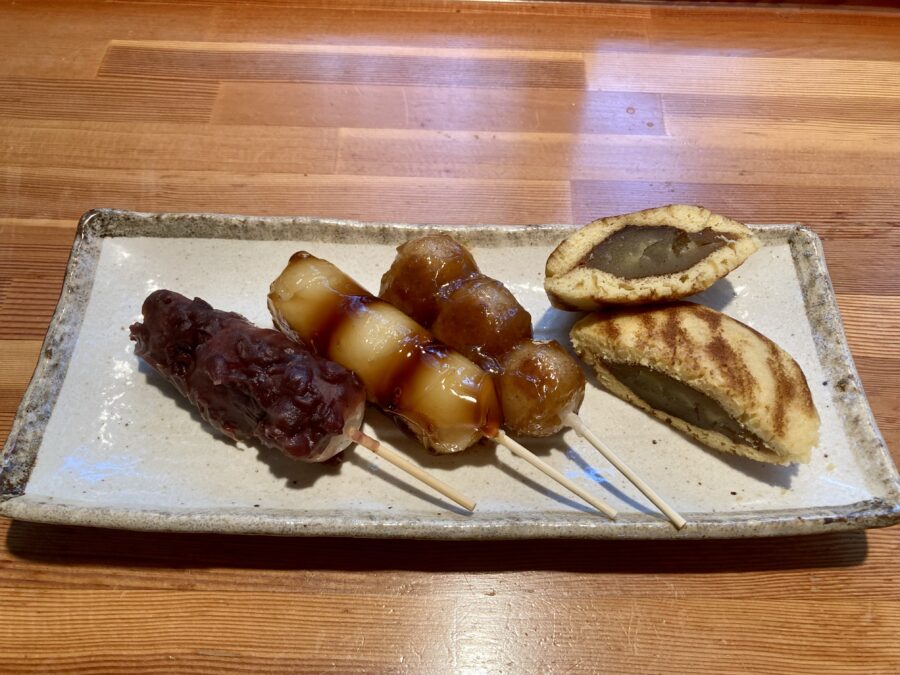
Traditional Japanese Sweets
和菓子
Have you been to a Japanese sweet shop? There are a lot of different kinds of Japanese sweets. Dorayaki may be the most famous Japanese sweet because it is the favourite sweet of Doraemon, a popular cartoon character. Of course, I love them as well.
和菓子屋(わがしや)さんへ行(い)ったことはありますか?違(ちが)う種類(しゅるい)の和菓子(わがし)がたくさんあります。中(なか)でも、どら焼(や)きは最(もっと)も有名(ゆうめい)な和菓子(わがし)でしょう。大人気(だいにんき)マンガのキャラクターであるドラえもんの大好物(だいこうぶつ)ですから。もちろん、わたしも大好(だいす)きです。
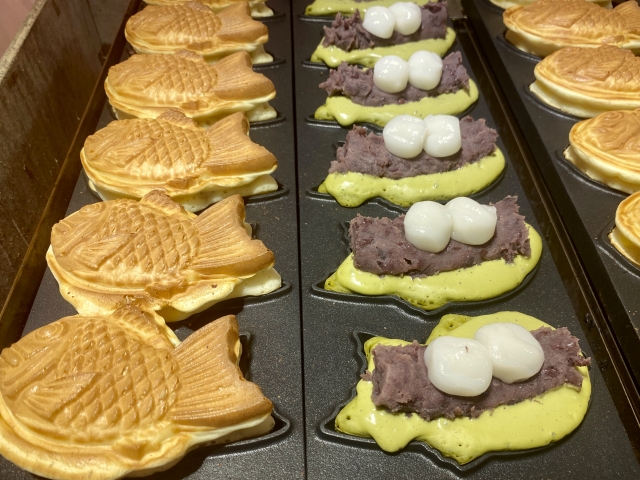
Here is the definition of Japanese sweets and the stark differences between Japanese sweets and Western ones. Sweets that came into Japan during or before the Edo era and afterwards were modified in Japanese ways are called Japanese desserts, the so-called Wagashi. Compared with Western sweets, they contain a large amount of water but not lipids, are generally small pieces and have fewer calories.
ここでは、和菓子(わがし)の定義(ていぎ)と、洋菓子(ようがし)との違(ちが)いについて説明(せつめい)しますね。江戸時代(えどじだい)もしくはそれ以前(いぜん)に日本(にほん)に入(はい)って来(き)た菓子(かし)で日本(にほん)で独自(どくじ)の進化(しんか)を遂(と)げたものを和菓子(わがし)と呼(よ)びます。洋菓子(ようがし)と比(くら)べると、水分量(すいぶんりょう)は多(おお)いけれども脂質(ししつ)が少(すく)なく、一般的(いっぱんてき)に個別(こべつ)の小(ちい)さな菓子(かし)でカロリーは控(ひか)えめです。
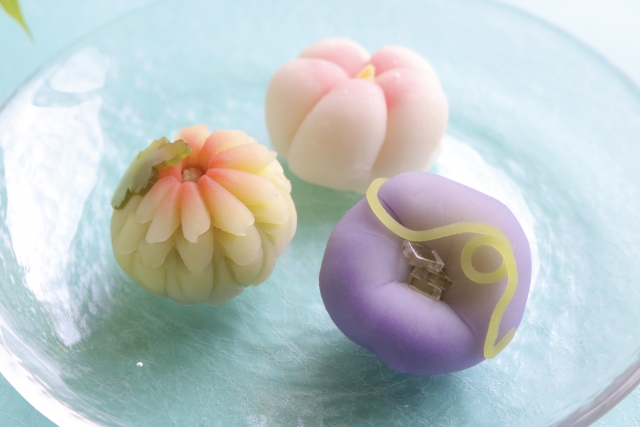
The picture above shows Nerikiri, one type of Japanese sweet often served with Japanese Green Tea Maccha (a very bitter taste). Nerikiri can be very colourful and has a design of seasonal flowers or items. Aren’t they too beautiful to eat? People appreciate both their tastes as well as their fantastic looks. By the way, if you would like to make them by yourselves, there are some activities in which you can participate. Click the following link. There are a few courses with reasonable fees. 日本全国のお菓子作り・和菓子作り
上(うえ)の写真(しゃしん)は練(ね)り切(き)りと呼(よ)ばれる和菓子(わがし)で、抹茶(まっちゃ)(とても苦(にが)い味(あじ)のお茶(ちゃ))に添(そ)えられます。練(ね)り切(き)りはとても色鮮(いろあざ)やかであったり、季節(きせつ)の花(はな)や物(もの)をモチーフに作(つく)られています。あまりにも芸術的(げいじゅつてき)すぎて食(た)べられませんね。素晴(すば)らしい色形(いろかたち)だけでなくその味(あじ)も 楽(たの)しまれています。ところで、もしご自身(じしん)で和菓子(わがし)を作(つく)ってみたいなら、和菓子作(わがしづく)り体験(たいけん)に参加(さんか)する事(こと)が出来(でき)ます。リンクをクリックして下(くだ)さい。手頃(てごろ)な費用(ひよう)で体験(たいけん)できる和菓子作(わがしづく)りコースがいくつかあります。
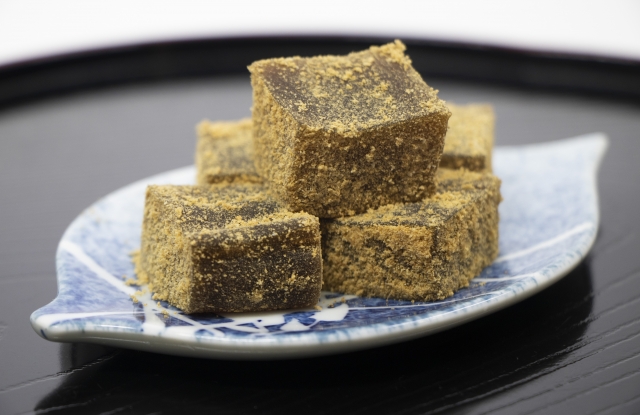
I will now introduce only a couple of Japanese sweets. First, it’s WARABI MOCHI made of Warabi powder and dipped in Kinako (Soy beans powder). It is a popular summer dessert, particularly in the Kansai region, such as Osaka and Kyoto. Anyone can make Warabimochi without hustle. I would often make one at home when I was small. Warabi powder is readily available at supermarkets in the Kansai region.
では、和菓子(わがし)を数種類(すうしゅるい)だけですが紹介(しょうかい)しましょう。まず、わらび餅(もち)です。わらび餅(もち)はわらび粉(こ)から作(つく)られ、きな粉(こ)という大豆(だいず)の粉(こな)をまぶしてあります。よく夏(なつ)に、特(とく)に大阪(おおさか)や京都(きょうと)などの関西地方(かんさいちほう)で食(た)べられています。誰(だれ)にでも簡単(かんたん)に作(つく)る事(こと)ができ、実際(じっさい)、私(わたし)も子供(こども)の頃(ころ)よく家(いえ)で作(つく)ったものです。わらび粉(こ)は関西地方(かんさいちほう)ではスーパーで簡単(かんたん)に手(て)に入(はい)ります。
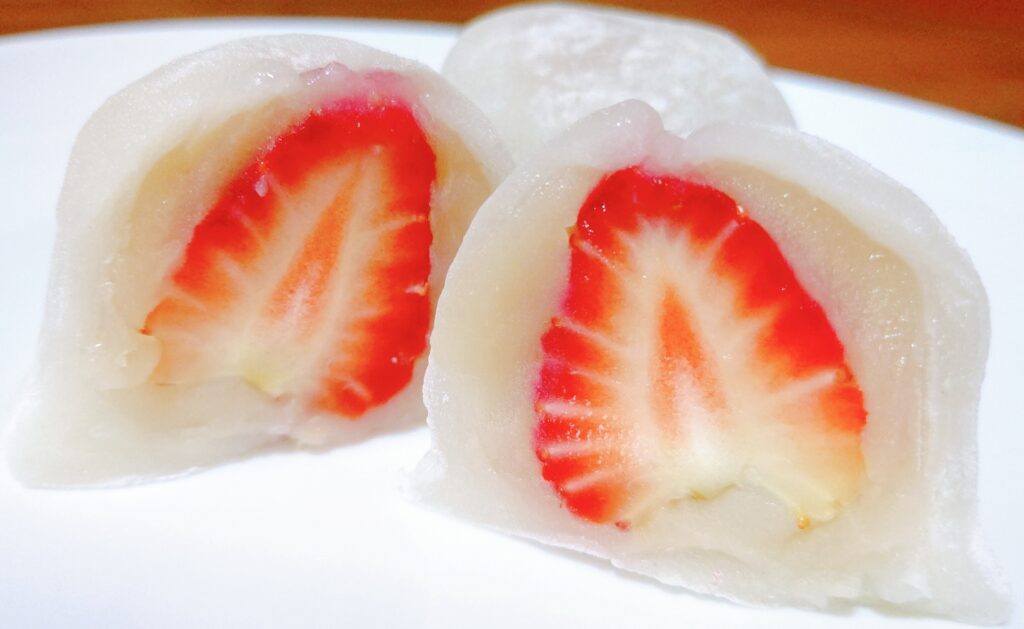
The next sweet is Ichigo-daifuku. Daifuku is a small round mochi with some sweet bean filling inside. The sweet bean filling is usually dark red or blackish, but the white one is also used to make Ichigo-daifuku. Different kinds of beans contribute to different colourings of sweet bean filling. Ichigo-daifuku contains a strawberry in the middle. Daifuku using other fruits are also available; Kiwi, Mandarin orange, Peach, etc. I strongly recommend Strawberry Daifuku with white filling!
次(つぎ)に紹介(しょうかい)する和菓子(わがし)はイチゴ大福(だいふく)です。大福(だいふく)とは小(ちい)さな丸(まる)い餅(もち)で中(なか)には甘(あま)いあんこが入(はい)っています。あんこは大体(だいたい)、暗(くら)い赤(あか)か黒(くろ)っぽい色(いろ)をしていますが、白(しろ)あんもイチゴ大福(だいふく)には使(つか)われます。違(ちが)う種類(しゅるい)の豆(まめ)を使用(しよう)するので、違(ちが)う色(いろ)のあんこになります。イチゴ大福(だいふく)は真(ま)ん中(なか)にイチゴが一粒(ひとつぶ)入(はい)っています。他(ほか)のフルーツを使(つか)った大福(だいふく)もあり、キウイ、みかん、桃(もも)などがあります。私(わたし)のお薦(すす)めは、断然(だんぜん)、白(しろ)あんのイチゴ大福(だいふく)です。
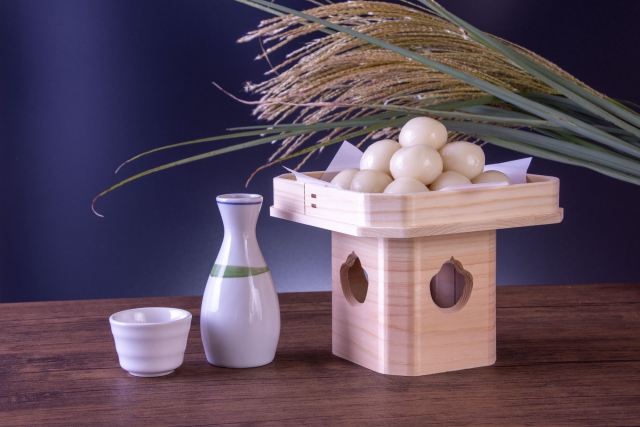
Lastly, the Japanese eat traditional Japanese sweets on seasonal occasions. At night with a full moon or nearly full moon in September or October (the date varies each year because it is calculated based on the old calendar.) The Japanese enjoy looking at the moon and eating Tsukimi-Dango, which are sphere-shaped like a full moon. This custom started among the aristocracy in the Heian era (859-877), drinking and enjoying string instruments on boats. Then it was popularised in the Edo era by celebrating the successful harvest of crops. Thereby, people today place some pampas grasses together with Tsukimi-Dango and eat the sweets while gazing at a full moon. Please look at this page for another seasonal occasion when people eat traditional Japanese desserts.
最後(さいご)に、日本人(にほんじん)は季節(きせつ)の行事(ぎょうじ)に和菓子(わがし)を食(た)べる習慣(しゅうかん)があります。9月(くがつ)か10月(じゅうがつ)の満月(まんげつ)、もしくは、ほぼ満月(まんげつ)の夜(よる)(その日(ひ)は決(き)まっておらず、旧歴(きゅうれき)を元(もと)にしているので毎年(まいとし)変(わか)ります。)、日本人(にほんじん)は、月(つき)を眺(なが)めて、月見団子(つきみだんご)をいただきます。月見団子(つきみだんご)とは、ちょうど満月(まんげつ)のような球体(きゅうたい)の団子(だんご)です。この習慣(しゅうかん)は平安時代(へいあんじだい)に、貴族(きぞく)の間(あいだ)で始(はじ)まり、船(ふね)でお酒(さけ)を飲(の)んだり管弦(かんげん)を楽(たの)しんでいました。その後(ご)、江戸時代(えどじだい)に、無事(ぶじ)の収穫(しゅうかく)を祝(いわ)うことにより、大衆化(たいしゅうか)しはじめました。それにより今(いま)では、月見団子(つきみだんご)と一緒(いっしょ)にススキを飾(かざ)り、満月(まんげつ)を眺(なが)めながら団子(だんご)を食(しょく)すのです。和菓子(わがし)を食(た)べる別(べつ)の季節行事(きせつぎょうじ)については、こちらの記事(きじ)をご覧(らん)ください。